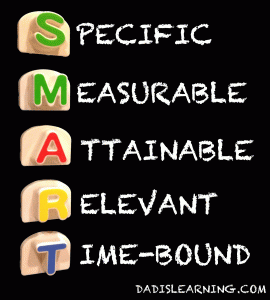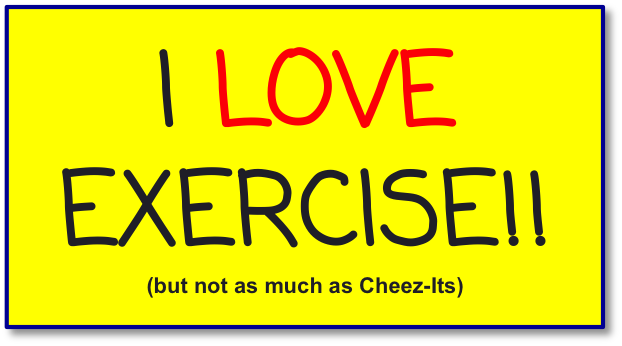Introducing a Little Exercise
The other day I came across a blog post titled “How to Become an Exercise Addict”. As a recovering “Cheez-It” addict, the title enticed me (not unlike Cheez-Its), and I read the post. Okay, part of the post. There were 21 steps to get to an exercise addiction, 18 too many for me. Turns out it was really about how to make exercise a habit, not an addiction. So even though my fantasy of replacing the Cheez-It addiction with exercise evaporated, I realized I could beat the other blogger by 14 whole steps, offering just 7 steps to make exercise a habit!! That’s a 200% reduction-savings for you, lazy habit makers, and please check my math.
What really occurred to me from the title is that most of us aren’t trying to get addicted; we’re just trying to introduce even some regular exercise into daily or weekly life. And that’s not a trivial task. Unfortunately, many articles on the subject address specific exercise excuses — “no time”, “too tired”, “it’s boring”, “no gym”, etc — and miss the core blocking factors. When it’s so important to quality of life, why is it so hard to start and sustain exercise habits? I’ll offer two simple reasons….
- Most of us experience exercise as a stressor, at least initially. Worthwhile exercise is work; hence, “workout”. While it reduces stress overall, and while exercise can be pleasurable over time, we typically don’t experience pleasure and stress reduction early on. When
 we’re first starting, it’s just hard. And other daily stressors can make it worse. The added stress and absence of instant results can quickly turn initial enthusiasm into throwing-in-the-towel. It’s not like opening a box of Cheez-Its. For inescapable reasons, human beings are hard-wired to resist hard exercise.
we’re first starting, it’s just hard. And other daily stressors can make it worse. The added stress and absence of instant results can quickly turn initial enthusiasm into throwing-in-the-towel. It’s not like opening a box of Cheez-Its. For inescapable reasons, human beings are hard-wired to resist hard exercise. - Forming new habits is a readily accessible but acquired skill, which requires knowledge, practice and adaptation. Many psychological and environmental variables — vision, motivation, self-efficacy, creating support resources, habit cues and rewards, etc. — need to be engaged. But most of us aren’t fully aware of these factors and how to manage them to achieve lasting change. It’s not a question of intelligence; it’s gaining exposure and experience.
A small number of us convert to regular exercise readily after a life-changing epiphany or trauma. For the rest of us epiphany-less seekers, the seven steps below will get you to the same destination. Here’s how to deal with the initial stress and make exercise a habit.
Step 1 — Create a Vision and Long Term Goals
What’s your vision? Why start exercising? Sure, you know it’s healthy, but what are your reasons? What’s the emotional connection? In other words, what inspirational qualities of life are you missing and seeking? Your vision is not “I want to lose 50 pounds” (that’s a goal, not a vision). Your vision will include something like “I want more energy, resilience and happiness”. Or “I want athletic competition again”. Or “I want be a role model for my kids and live longer.” Whatever the vision is, it’s the backbone of your motivation; it’s your story. Consider what you have to lose if you don’t achieve your vision. It doesn’t have to be complex or poetic, but write it down, remember it, and come back to it frequently. It’s the foundation that ties all other pieces of your exercise program together. Thinking/dreaming big stokes your motivation.
Once your vision is clear, create some long term goals (no shorter than 3 months) to directly support it. Examples? Lose fifty pounds, or compete in a half marathon, or play tennis regularly. But any goal needs to be consistent with your vision, and it needs to be adaptable, changing with your experience and learning.
If you can’t envision some long term goals to support your vision, then skip to step 2 below and come back to your long term goals.
Step 2 — Find the Fun and Experiment
When you’re getting started, it’s better to think “fun activity” than “regimented exercise”. Doing anything fun — and, no, that doesn’t include shooting pool and hoisting heavy beer mugs — is better than losing interest in something super rigorous but un-fun. Don’t start or settle on something that’s too hard, a bad personal fit, and no fun. It will kill your motivation, not bolster it.
If you don’t know what’s fun for you, you’re not alone. Many wellness clients lose touch with that after years of prioritizing family/career/etc over exercise. If that’s you, take the time to experiment and find the fun. Think expansively about past activities you’ve enjoyed — even as a kid — and new potential ones. Not all activity needs to be pure fun or mostly fun; if you’re aiming for body adaptation, some of your activity has to be harder. But it’s all on a spectrum, and over time tough exercise — though difficult — can be very satisfying.
Embrace experimentation. If you try something that doesn’t work, understand why without personal judgment, adjust and trying something else. A smart experiment with an undesirable result is not a failure. It’s a necessary step, and creates opportunities for refinement and success.
Finally, variety is good. It’s a hedge against boredom and actually good for your body, forcing more physiological adaptation. Yoga, weight-lifting and cycling — for example — could provide an effective balance of strength, flexibility and aerobic fitness that one of those activities alone could not provide (easily). So you don’t have to settle on just one activity. In any case, there’s something for everyone; you just need to find it.
Step 3 — Create SMART Short Term Goals
Vision is necessary and produces more/better motivation. But it’s not actionable by itself. You can’t chase a lofty goal or even a three month goal every day. You can chase a micro-goal, and it’s a short chase. They promote habit formation — the grist for the wellness change mill — allowing you to achieve, track, and advance mindfully and progressively.
Here are the simple rules for setting your short term goals:
- Make ’em SMART: Specific, Measurable, Attainable, Relevant, Timebound.
 Example of a SMART goal (behavioral, in this case): “Get to the gym on Tues, Thurs and Saturday from 6:15 to 7:00 am. Do these specific ___ exercises. Log my workout and progress either the weight, number of repetitions or time under load each session for each exercise. All to increase my basal metabolism for longer term weight loss.”
Example of a SMART goal (behavioral, in this case): “Get to the gym on Tues, Thurs and Saturday from 6:15 to 7:00 am. Do these specific ___ exercises. Log my workout and progress either the weight, number of repetitions or time under load each session for each exercise. All to increase my basal metabolism for longer term weight loss.” - Set the bar lower — rather than higher — until you know what you can produce or achieve. This is the “Attainable” in SMART. You want to build your own sense of self-efficacy — your sense that you are capable of accomplishing certain tasks — because that breeds performance success, greater perseverance, and in turn greater self-efficacy. It’s a positive feedback loop. By contrast, failure diminishes self-efficacy and performance. Micro goals should be challenging enough to achieve (usually), but not so tough as to produce frequent failure and not so easy as to feel trivial or uninspiring.
- Stating the obvious, make your micro goals consistent with your three month goals and vision. If you want to compete as a triathlete, frequent weight-lifting might not make sense. This is the “Relevant” in SMART.
- Where you can, make your micro-goals habits-in-formation, or the precursor to habits. Be intentional about using cues and rewards in building exercise habits. And don’t buy the myth that it will only take 21 days to form your daily habits; it varies for everyone, but it’s typically longer than 21 days. See more on habits here.
Step 4 — Identify and Shore Up Your Supports
Do you have the equipment you need? Have you made schedule and logistical adjustments to clear the path for exercise? Do you want exercise partners? Are friends and family set up to provide the support you need, or at least to stay out of your way? If not, include these support efforts in your micro goals.
 Social exercise (teams, groups, partners) can definitely enhance the fun and performance. If you have exercise partners, don’t hitch your wagon to them in a way that gives you an excuse not to exercise if they can’t make it. Consider than fitter exercise partners will raise your performance, assuming they provide an appropriate level of challenge (see above).
Social exercise (teams, groups, partners) can definitely enhance the fun and performance. If you have exercise partners, don’t hitch your wagon to them in a way that gives you an excuse not to exercise if they can’t make it. Consider than fitter exercise partners will raise your performance, assuming they provide an appropriate level of challenge (see above).
Step 5 — Manage Your Brain
Assuming you’ve done all of the above well, you’ll still encounter your own resistance. Environmental challenges — like anyone who can disrupt your exercise schedule — will contribute to your resistance. How do you manage it?
First, be mindful of it and acknowledge it’s existence. Ask yourself what the resistance is about. Don’t mentally sweep it under the rug; it’s not a character flaw or moral failure to feel unmotivated some days. Internal resistance doesn’t mean you won’t exercise; it’s just a normal cognitive pattern that’s manageable through practice. Once you’ve seen your own resistance repeatedly and know how it arises, plan for it and use the strategies below to work through it.
Once you’ve acknowledged the resistance, remind yourself why your exercising and recall your vision. And remember past exercise session successes and how good they felt. Second, get out of your own head. See here for a full blog post on this subject. Generally, it means seeing and stopping the useless internal debate; every second of monkey-mind debating makes it less likely you will exercise.
Finally, don’t suffer from all-or-nothing syndrome. Your options aren’t just the 1 hour weights workout as planned or nothing, for example. A twenty minute session or even walk is better than nothing. Perfection is the enemy of progress. Over the long haul, consistent sessions and firmly establishing the exercise habit is a bigger win.
Step 6 — Sleep and Eat Right
In a word, this means recovery. Exercise creates micro-tears in muscle tissue. It’s the healing/repairing cycle that builds new muscle and aerobic/anaerobic capacity. If you’re not eating and sleeping to support your exercise, you’re standing in the way of your own progress.
A ton has been written on food and sleep to support exercise — and I won’t try to repeat that here — but here are a few quick facts:
- Sleep deprivation leads to poor judgment, emotional fragility, food cravings and low energy (and other scarier outcomes). Pretty much the last things you need if you’re trying to build motivation for a new exercise program.
- Sleep needs are variable, but you’ll
 need somewhere between 7.5 and 9 hours a night. If you’re exercising more, you’ll need more sleep or better quality sleep. Scheduling a consistent go-to-bed time is the single biggest hedge against loss of sleep and poor quality sleep.
need somewhere between 7.5 and 9 hours a night. If you’re exercising more, you’ll need more sleep or better quality sleep. Scheduling a consistent go-to-bed time is the single biggest hedge against loss of sleep and poor quality sleep. - A new exercise program will probably make you more hungry. Respond by eating whole foods, eliminating added sugar, and eating plenty of healthy protein to support muscle synthesis. Studies show that diet and exercise change work best together, not done separately or one at a time.
Step 7 — Track It, Progress and Adapt
Tracking your exercise, adapting wisely through good experimentation (as described above), and rewarding results all go together. You can’t manage and learn from what you don’t measure. Knowing that you are progressing helps build your sense of self-efficacy and motivation. A few brief tips:
- Don’t go nuts with your logging. Logging is not exercising; it’s a means to an end, not the end itself. If your logging device is dead, go for that walk, run or ride anyway.
- The only simple rule is log enough to be able to adapt and improve. After that, experiment to discover what works for you. There are too many effective diet and exercise logging apps out there to mention; just pick one, try it, and use it. Pencil and paper will work fine, if you’ve had enough technology.
- Use your tracking to support and direct your micro-goals. You can record biometric or exercise stats — heart rate, number of steps, time under load, weight, number of repetitions, distance, whatever you like — and then experiment creatively with progressing at least one factor on a regular basis. Even less competitive people are motivated by seeing progressive improvement in exercise statistics.
There are the seven steps (like the Samurai, without the swords and haircuts) from an evidence-based approach, but your mileage may vary. Because natural preferences, body types, etc are different, you’ll have to experiment mindfully. Embrace experimentation, but in any scenario, just start somewhere.
 You probably don’t need a gym membership. Or outfits. Or permission. To begin, begin. Enjoy, and step away from the Cheez-Its.
You probably don’t need a gym membership. Or outfits. Or permission. To begin, begin. Enjoy, and step away from the Cheez-Its.





